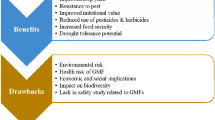Abstract
Crops are being genetically engineered to produce a wide variety of drugs, vaccines and other pharmaceutical proteins. Although these crops may open the door to less expensive and more readily available drugs, there is concern regarding the potential for contamination of human food and livestock feed, as well as environmental harm. The outlook for the production of pharmaceutical crops in California currently appears mixed. To date, 18 federal permits for field trials involving pharmaceutical or industrial proteins have been approved in California. However, the state’s farming community and general public have thus far rejected pharmaceutical crop production, and a handful of local governments have recently banned the cultivation of genetically modified crops, including pharmaceutical crops. In light of the many pros and cons, three major approaches — the precautionary approach, risk analysis and cost-benefit analysis — could be used to move the debate about pharmaceutical crops forward.
Similar content being viewed by others
References
Bilsborrow P.E., Evans E.J., Bowman J. et al. (1998) Contamination of edible double-low oilseed rape crops via pollen transfer from high erucic cultivars, J. Sci. Food Agr. 76, 17–22.
Conko G. (2003) Safety, risk and the precautionary principle: Rethinking precautionary approaches to the regulation of transgenic plants, Transgenic Res. 12, 639–647.
Daniell H., Khan M.S., Allison L. (2002) Milestones in chloroplast genetic engineering: An environmentally friendly era in biotechnology, Trends Plant Sci. 7, 84–91.
Editors of Nature Biotechnology (2004) Drugs in crops — the unpalatable truth, Nat. Biotechnol. 22, 133.
Elbehri A. (2005) Biopharming and the food system: Examining the potential benefits and risks, AgBioForum 8, 18–25.
Ellstrand N.C. (2006) When crop transgenes wander in California, should we worry? Calif. Agr. 60, 116–125.
EuropaBio (2006) Understanding coexistence: Science, principles and practical experience, ABE/EuropaBio. www.europa-bio.be/documents/040406/Understanding%20Coexistence%20Fact %20File.pdf.
Federal Register (2003) Field testing of plants engineered to produce pharmaceutical and industrial compounds, Fed. Reg. 68, 11337–11340.
Fischer R., Stoger E., Schillberg S. et al. (2004) Plant-based production of biopharmaceuticals, Curr. Opin. Plant Biol. 7, 152–158.
Giddings G., Allison G., Brooks D. et al. (2000) Transgenic plants as factories for biopharmaceuticals, Nat. Biotechnol. 18, 1151–1155.
Horn M.E., Woodward S.L., Howard J.A. (2004) Plant molecular farming: Systems and products, Plant Cell Rep. 22, 711–720.
Keenan R.J., Stemmer W.P.C. (2002) Nontransgenic crops from transgenic plants, Nat. Biotechnol. 20, 215–216.
Kirk D.D., McIntosh K., Walmsley A.M. et al. (2005) Risk analysis for plant-made vaccines, Transgenic Res. 14, 449–462.
Ma J.K.-C., Drake P.M.W., Christou P. (2003) The production of recombinant pharmaceutical proteins in plants, Nat. Rev. Genet. 4, 794–805.
Ma J.K.-C., Barros E., Bock R. et al. (2005a) Molecular farming for new drugs and vaccines, EMBO Rep. 6, 593–599.
Ma J.K.-C., Chikwamba R., Sparrow P. et al. (2005b) Plant-derived pharmaceuticals — the road forward, Trends Plant Sci. 10, 580–585.
Macilwain C. (2005) US launches probe into sales of unapproved transgenic corn, Nature 434, 423.
Marvier M., Van Acker R. (2005) Can crop transgenes be kept on a leash? Front. Ecol. Environ. 3, 99–106.
Mascia P.N., Flavell R.B. (2004) Safe and acceptable strategies for producing foreign molecules in plants, Curr. Opin. Plant Biol. 7, 189–195.
National Research Council (2004) Biological Confinement of Genetically Engineered Organisms, Naticnal Academy Press Washington, DC, 284 p.
O’Brien M. (2000) Making Better Environmental Decisions: An Alternative to Risk Assessment, MIT Press, Cambridge, MA, 352 p.
Peterson R.K.D., Arntzen C.J. (2004) On risk and plant-based biopharmaceuticals, Trends Biotechnol. 22, 64–66.
Raskin I., Ribnicky D.M., Komarnytsky S. et al. (2002) Plants and human health in the twenty-first century, Trends Biotechnol. 20, 522–531.
Sala F., Rigano M.M., Barbante A. et al. (2003) Vaccine antigen production in transgenic plants: Strategies, gene constructs and perspectives, Vaccine 21, 803–808.
Stewart P.A., Knight A.J. (2005) Trends affecting the next generation of U.S. agricultural biotechnology: Politics, policy, and plant-made Pharmaceuticals, Technol. Forecast Soc. 72, 521–534.
Stewart P.A., McLean W. (2004) Fear and hope over the third generation of agricultural biotechnology: Analysis of public response in the Federal Register, AgBioForum 7, 133–141.
Union of Concerned Scientists (2003) Pharm and Industrial Crops: The Next Wave of Agricultural Biotechnology, Cambridge, MA, www.ucsusa.org/food_and_environment/genetic_engineering/pharm-and-industrial-crops.html.
Union of Concerned Scientists (2007) Pharma Crop Approvals in the United States, Cambridge, MA, http://go.ucsusa.org/food_and_environment/pharm/(accessed Feb.18, 2007).
[USDA] US Department of Agriculture (2005) Audit Report: Animal and Plant Health Inspection Service Controls Over Issuance of Genetically Engineered Organism Release Permits, Office of the Inspector General, Audit #50601-8-Te, December.
[USDA APHIS] Animal and Plant Health Inspection Service (2007) USDA Release Permits for Pharmaceuticals, Industrials, Value Added Proteins for Human Consumption, or for Phytoremediation Granted or Pending by APHIS, www.aphis.usda.gov/brs/ph_permits.html.
Vogel G. (2006) Tracing the transatlantic spread of GM rice, Science 313, 1714.
Walmsley A.M., Arntzen C.J. (2000) Plants for delivery of edible vaccines, Curr. Opin. Biotechnol. 11, 126–129.
Wisner R. (2005) The Economics of Pharmaceutical Crops: Potential Benefits and Risks for Farmers and Rural Communities, Union of Concerned Scientists, Cambridge, MA, www.ucsusa.org/food_and_environment/genetic_engineering/economics-of-pharmaceutical-crops.html.
Author information
Authors and Affiliations
Corresponding author
Additional information
Reprinted with permission from Marvier M. (2007) Pharmaceutical crops have a mixed outlook in California, Calif. Agr. 61, 59–66. Copyright: 2007 Regents of the University of California. Permission has been kindly given by Janet Byron, managing Editor of California Agriculture journal. URL: http:/CaliforniaAgriculture.ucop.edu
About this article
Cite this article
Marvier, M. Pharmaceutical crops in California, benefits and risks. A review. Agron. Sustain. Dev. 28, 1–9 (2008). https://doi.org/10.1051/agro:2007050
Accepted:
Issue Date:
DOI: https://doi.org/10.1051/agro:2007050



